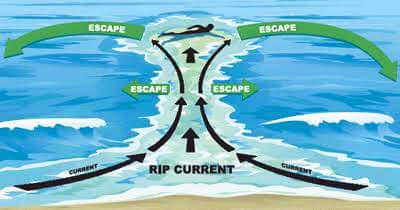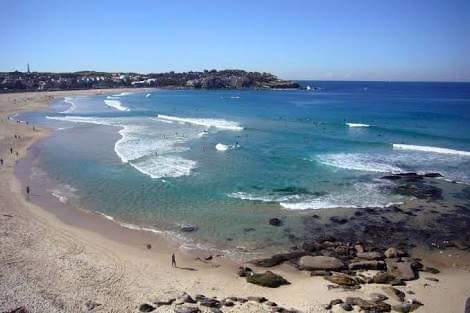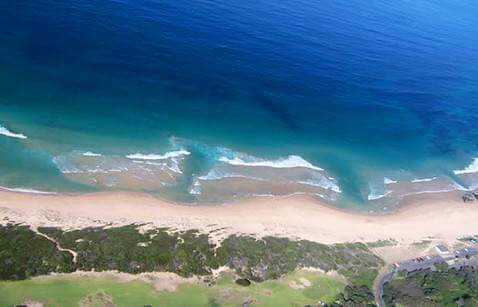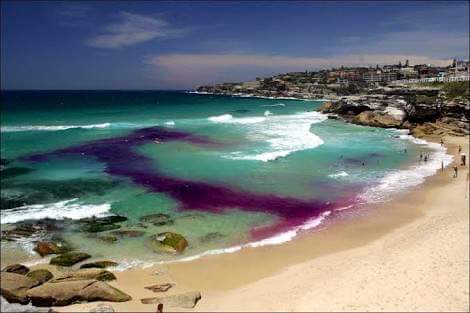As a former surf lifesaver I constantly find myself when I’m at a beach automatically in patrol mode, and I’m always troubled seeing the amount of swimmers that enter the surf straight into a rip zone. This includes, and most worrying of all children. I know a lot of people are kind of aware of what to do if caught in a rip, but it has been brought to my attention recently that a lot of people aren’t aware of what a rip actually looks like or where the safest place to swim at the beach is if there is no flagged area.
One person will drown every two to three days this summer… 90% of those fatalities will be rip-related. Here are a few things that will help you and your kids stay safe this summer. I have also put together a few images that show what to look for.
1. The easiest thing to remember is that often the safest/calmest most enticing looking area along a beach is usually a rip. A rip is usually the area void of wave activity and appears darker and deceptively calmer. It can sometimes appear milky or turbulent, but it is always pretty much void of wave activity. All that water coming in via waves has to go back out somehow, this is what a rip is. (see pics).
2. Always take 5-10 mins when you get to the beach to observe surf conditions and identify where these areas are.
3. If you are caught in a rip, DO NOT PANIC. Go into floating mode and raise one arm as a distress signal when possible. See which direction the rip is taking you, is it straight out or at an angle? once you have determined this, and if you have the energy, swim to the right or left of the direction of flow, never against. Some rips can move at 3 times the speed of an olympic swimmer, you won’t win! If you cannot swim out to either side of the rip, just go with it. Most rips won’t take you out very far, and will usually spit you out not long after they take you, so keep calm and save your energy for the swim back to shore.
4. If you have kids, show them these pictures, educate them and make them aware. You can’t always be watching them, and it is only a matter of a few metres each way of the point of entry to the water that could mean them being safe, or instantly caught in a rip.
Obviously the safest place to swim is always between the flags on a patrolled beach, but this isn’t always practical given the immensity of our coast line and number of beautiful beaches. Of course there are many other factors that can come into play when it comes to beach safety, but rips are the No.1 killer. They are not hard to identify, and 10 mins observation before entering the surf is much easier than body retrieval.
*The darker/calmer areas in the pics are rips. The one with purple dye shows rip movement.
This post popped up on my facebook page and felt it was something that should be shared everywhere. I reposted the points again after the pictures as I thought they were so important and needed repeating.
One person will drown every two to three days this summer… 90% of those fatalities will be rip-related. Here are a few things that will help you and your kids stay safe this summer. I have also put together a few images that show what to look for.
1. The easiest thing to remember is that often the safest/calmest most enticing looking area along a beach is usually a rip. A rip is usually the area void of wave activity and appears darker and deceptively calmer. It can sometimes appear milky or turbulent, but it is always pretty much void of wave activity. All that water coming in via waves has to go back out somehow, this is what a rip is. (see pics).
2. Always take 5-10 mins when you get to the beach to observe surf conditions and identify where these areas are.
3. If you are caught in a rip, DO NOT PANIC. Go into floating mode and raise one arm as a distress signal when possible. See which direction the rip is taking you, is it straight out or at an angle? once you have determined this, and if you have the energy, swim to the right or left of the direction of flow, never against. Some rips can move at 3 times the speed of an olympic swimmer, you won’t win! If you cannot swim out to either side of the rip, just go with it. Most rips won’t take you out very far, and will usually spit you out not long after they take you, so keep calm and save your energy for the swim back to shore.
4. If you have kids, show them these pictures, educate them and make them aware. You can’t always be watching them, and it is only a matter of a few metres each way of the point of entry to the water that could mean them being safe, or instantly caught in a rip.
Obviously the safest place to swim is always between the flags on a patrolled beach, but this isn’t always practical given the immensity of our coast line and number of beautiful beaches. Of course there are many other factors that can come into play when it comes to beach safety, but rips are the No.1 killer. They are not hard to identify, and 10 mins observation before entering the surf is much easier than body retrieval.
*The darker/calmer areas in the pics are rips. The one with purple dye shows rip movement.










Reblogged this on Chris The Story Reading Ape's Blog and commented:
Thanks to Phoenix, you now know exactly what to look out for…
LikeLiked by 1 person
Thanks Chris. I thought it was very important and needed to be shared when it popped up on my facebook page.
LikeLiked by 1 person
Indeed it is Phoenix 👍
LikeLiked by 1 person
This is great advice. There is a dangerous rip on the beach where I live and over the years several people have drowned.
LikeLiked by 1 person
HI Annabelle, yes very good advice and hope you will share as I think it is so important and needs to go viral.
It popped up on my facebook page and was grateful to the person who shared.
Thanks for taking the time to stop by my blog and comment.
LikeLiked by 1 person
Shared! 🙂
LikeLiked by 1 person
Thanks 🙂
LikeLike
I didn’t know this! As a very weak swimmer I would definitely go for that wave ripple free zone, the calm safe looking splash free bit of water. I won’t now ever!
Thank you for saving my actual life.
LikeLiked by 1 person
I didn’t know this either and was grateful to the person who took the time to explain this. I too, looked for calmer waters to swim in, but won’t in future. It popped up on my facebook page and knew it was something worth sharing. I really hope this goes viral. It will save lives.
LikeLiked by 1 person
Thank you for this important information. We lost my cousin, Tina Groschke a few years ago in Mexico on a diving vacation. They believe she was swept away by a rip tide while attempting to ascend. She was there one minute, signalling her husband she needed to surface, the next moment, she was gone. They never found her…
LikeLiked by 1 person
I am so sorry for your loss, such a tragedy and hopefully this will go viral so more people are aware of rip tides.
LikeLiked by 1 person
Good advice. As with all things, reminders of any kind are never a waste. 🙂
LikeLiked by 1 person
Thanks for your comment. Yes this information is so important and I am very grateful to the person who shared it on my facebook page. I always make the mistake of looking for the quiet water to swim in and on one occasion felt myself being pulled out to sea. It was very scarey but I stayed calm and managed to swim out towards the waves going inland and used them to take me back to the beach. I was fortunate it was not a full on rip tide, but more of an undercurrent that was pulling me out to sea.
LikeLiked by 1 person
Gives me the shiver. Whew. Talk about a lucky outcome. 🙂
LikeLiked by 1 person
I agree. This is so important and needs to be shared.
Thanks for stopping by and commenting.
LikeLiked by 1 person
You are welcome. 🙂
LikeLiked by 1 person
Invaluable. Thankyou.
LikeLiked by 1 person
A real eye opener. I learned something new.
LikeLike
Excellent advice and great photos. My brother went after his daughter, who’d gotten caught in a riptide. Managed to get her out by going with the flow and angling in to the beach.
LikeLiked by 1 person
So glad to hear your brother and his daughter made it safely back to the beach.
I did the same thing when I was caught and have learnt the reason why this happened now that I have read this post.
It poppped up on my facebook page and I felt it was worth sharing.
LikeLiked by 1 person
Thanks for taking the time to read and comment. Please share so more people are aware.
LikeLike
Things I didn’t know, but surely should have. Thank you for sharing while educating others.
LikeLiked by 1 person
Thank you for taking the time to read and comment. Please consider sharing so more people are aware.
LikeLiked by 1 person
You are right. I did share on FB, but the word needs to get out everywhere!
LikeLiked by 1 person
Yes they definitely do. Thanks for sharing.
LikeLiked by 1 person
Very valuable advice here and things I’d never thought of living in a concrete jungle. Thanks for sharing this.
LikeLiked by 1 person
Thank you for stopping by my blog and commenting. Please share so others are aware. So many people go on sea side holidays.
LikeLiked by 1 person
Done! 🙂
LikeLiked by 1 person
Pingback: IMPORTANT ADVICE FOR ALL BEACH LOVERS | Annette Rochelle Aben